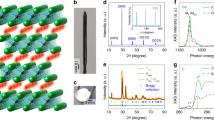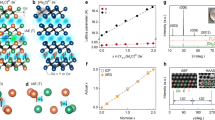Abstract
Electrides are crystalline salts in which stoichiometric amounts of trapped or itinerant electrons serve as the anions1–8. The cations are alkali metal cations complexed by cyclic or bicyclic polyethers of the crown ether9 or cryptand10 classes. Optical spectra, powder conductivities and magnetic susceptibilities show that, in most electrides, individual electron localization occurs, presumably centred at the anionic sites, with trap depths of 0.5–1.0 eV. An exception is K+(cryptand[2.2.2]) ˙e-, which has a plasma-like optical absorption spectrum2, high microwave conductivity, a low activation energy for direct current powder conductivity (∼0.02 eV), and a weak, temperature-dependent electronic paramagnetic susceptibility. The crystal structure of this electride shows the presence of large (4×6×12Å) vacancies of complex shape, interconnected in two directions by zigzag channels, but blocked in the third direction. The structure and properties suggest the presence of weakly bound electron pairs.
This is a preview of subscription content, access via your institution
Access options
Subscribe to this journal
Receive 51 print issues and online access
$199.00 per year
only $3.90 per issue
Buy this article
- Purchase on Springer Link
- Instant access to full article PDF
Prices may be subject to local taxes which are calculated during checkout
Similar content being viewed by others
References
Dye, J. L., Yemen, M. R., DaGue, M. G. & Lehn, J.-M. J. chem. Phys. 68, 1665–1670 (1978).
DaGue, M. G., Landers, J. S., Lewis, H. L. & Dye, J. L. Chem. Phys. Lett. 66, 169–172 (1979).
Ellaboudy, A., Dye, J. L. & Smith, P. B. J. Am. chem. Soc. 105, 6490–6491 (1983).
Dye, J. L. & Ellaboudy, A. Chem. Brit. 20, 210–215 (1984).
Dye, J. L. Prog. inorg. Chem. 32, 327–441 (1984).
Dawes, S. B., Ward, D. L., Huang, R. H. & Dye, J. L. J. Am. chem. Soc. 108, 3534–3535 (1986).
Dye, J. L. & DeBacker, M. G. A. Rev. Phys. Chem. 38, 271–301 (1987).
Dye, J. L. Scient. Am. 257, 66–75 (1987).
Pedersen, C. J. J. Am. chem. Soc. 89, 7017–7036 (1967).
Dietrich, B., Lehn, J.-M. & Sauvage, J. P. Tetrahedron Lett. 2885–2888 (1969).
Tehan, F. J., Barnett, B. L. & Dye, J. L. J. Am. chem. Soc. 96, 7203–7208 (1974).
Harris, R. L. & Lagowski, J. J. J. phys. Chem. 82, 729–734 (1978).
Thompson, J. C. Electrons in Liquid Ammonia (Oxford University Press, 1976).
Edwards, P. P. Adv. inorg. Chem. Radiochem. 25, 135–185 (1982).
Moras, P. D., Metz, B. & Weiss, R. Acta crystallogr. B29, 383–388 (1973).
Author information
Authors and Affiliations
Rights and permissions
About this article
Cite this article
Huang, R., Faber, M., Moeggenborg, K. et al. Structure of K+(cryptand[2.2.2J) electride and evidence for trapped electron pairs . Nature 331, 599–601 (1988). https://doi.org/10.1038/331599a0
Received:
Accepted:
Issue Date:
DOI: https://doi.org/10.1038/331599a0
This article is cited by
-
Exploring the effect of complexant on remarkably high static and dynamic second hyperpolarizability of aziridine-based diffuse electron systems: a theoretical study
Structural Chemistry (2023)
-
Electronic, Dielectric and Plasmonic Properties of Two-Dimensional Electride Materials X2N (X=Ca, Sr): A First-Principles Study
Scientific Reports (2015)
-
Pressure-stabilized lithium caesides with caesium anions beyond the −1 state
Nature Communications (2014)
-
An electride with a large six-electron ring
Nature (1994)
-
Anionic electrons in electrides
Nature (1993)
Comments
By submitting a comment you agree to abide by our Terms and Community Guidelines. If you find something abusive or that does not comply with our terms or guidelines please flag it as inappropriate.



